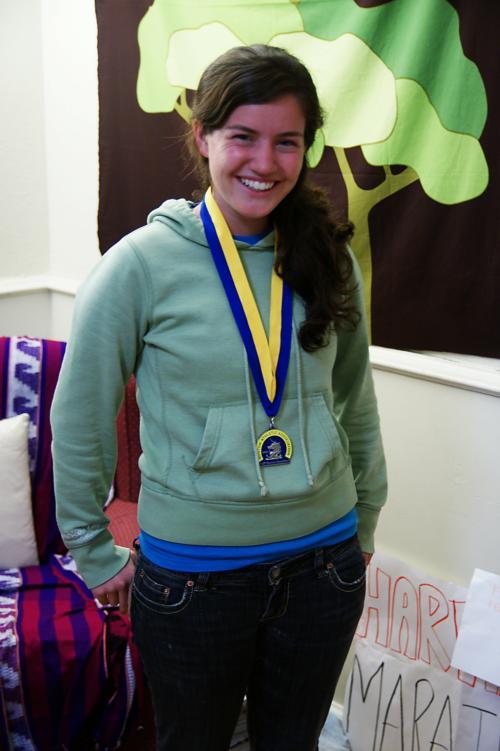
True Overachievers
You are running the Boston Marathon.
Somewhere in the 26.2 miles from the Hopkinton start to the Boston finish, you begin to have doubts. More than half of the course is behind you, but Heartbreak Hill still looms ahead—that steep one-half mile ascent.
“My legs started falling apart,” Yuting P. Chiang ’10 says. “Little muscles I didn’t even know existed cramped up. I was about to hit Heartbreak Hill, and I was feeling dehydrated.”
Chiang managed to pull through and cross the Copley Square finish line in four hours and 26 seconds. And he wasn’t alone. Among the thousands of participants in the Boston Marathon on April 21 were two dozen Harvard students, each of whom had their own motivation to enter, run, and finish the 26.2 miles that comprise the world’s oldest annual marathon.
I RUN FOR...
Twenty three Harvard students and two Harvard affiliates ran the Boston Marathon through the Harvard College Marathon Challenge (HCMC), which facilitates yearly student participation by reserving spots for potential runners. These students run to raise money for Phillips Brooks House Association and Project HEALTH, an organization that works to raise public-health awareness. Chiang was one of these 23 HCMC runners.
While many Harvard students team up with HCMC for the marathon, others chose to pursue a less official route—running “bandit,” or running the marathon without officially registering. Because the Boston Athletic Association prohibits people from registering unless they are running for charity or meet a specific qualifying time (which depends on both the runner’s age and gender), for many, bandit is the only way to cross the finish line. Colin P. Kelly ’08, a Boston marathon bandit, decided to run the marathon a week before the event itself.
Whether running officially or unofficially, Harvard students each have personal reasons for running the marathon. As the 112th Boston Marathon rolled around, Kelly drew upon his impending graduation as a source of motivation. “I always wanted to do it, and this was my last chance,” he says.
Marianne Eagan ’10, on the other hand, found motivation outside herself. Eagan says that she and her sister made a deal to run the race together. “My sister and I just shook on it over Thanksgiving,” Eagan says.
Although Eagan missed the HCMC application deadline in the fall, she managed to secure a spot with HCMC as the race drew nearer. “I would have ran ‘bandit’ but [HCMC] offered me the opportunity to get a number and do something for charity, which I really thought added to the experience.” Eagan crossed the finish line in three hours, 50 minutes and 41 seconds.
Eagan’s sister was by her side throughout the entire process. They trained several times a week, running up to 22 miles together in preparation for the marathon. Other Harvard students pursued a less regimented approach to their training. Kelly, for example, only completed two runs—one 11 mile and one 15 mile—in preparation for the 26.2 miles he would face.
But what Kelly lacked in preparation, he more than made up for in creativity. Kelly approached the finish line in bright yellow sunglasses and a bright blue and yellow outfit to match his blue and yellow Adidas sneakers. Kelly says his running attire was the best part of the experience. “After mile six,” he says, “even if [the crowd] didn’t know my name, I still got compliments on my sunglasses.”
Chiang dressed appropriately as well, wearing a remnant of his high school track and cross-country uniform: his lucky boxers.
THE AMAZING RACE
While lucky drawers and yellow shades can help surmount the physical feat of running the marathon, sometimes the mental hurdle is just as difficult to overcome.
During the night before the race, Eagan recalled how the anticipation was almost as bad as the run itself. “I was in my bed for seven hours, but I probably slept for three and a half,” Eagan says. “I was just in my bed, tossing and turning and imagining I don’t even know what.”
But once they crossed the starting line, the runners’ fears vanished. “I was feeling good,” Kelly says. “First few miles, you’re just cruising. Local people are out. The town comes alive. It’s fun.”
By the middle of the race, however, while their nerves were nullified, many of the runners were beginning to really feel the physical burn. “Awful” was the one word Eagan could find to describe it.
For many, the pain is so bad that reaching the finish line seems like an impossibility. Nick J. Shearer ’09, who ran the Boston Marathon for the third time this year, finished in four hours and 12 minutes—a personal best. Shearer mentions the physical intensity inherent in the process. “So much can go wrong,” he says. “You can get a blister. You can get cramps. You run by the medical centers along the course, and you see people with tears on their faces because they can’t keep going.”
But throughout those 26.2 painful miles, Bostonians fill the streets to support the runners. Their presence is buoyant, their cheers invigorating.
“It’s amazing how this crowd can get behind these runners they’ve never met before,” Shearer adds. “The pro-athletes have come and gone, but they’re staying to watch you—to support average, normal people trying to run 26.2 miles. The crowds are what make Boston so special.”
And nothing compares to crossing the finish line. “The crowd was huge,” Chiang says. “I was thinking, this is what it feel like to be a rock star.”


